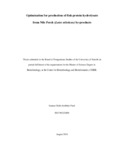| dc.description.abstract | The global rising concern for food and environmental security has forced established
industries such as fish processingto explore new areas of improvement. In Kenya thus far,
no studies have been carried out to explore the use of enzyme technology in the possible
recovery of products of high nutritional value from industrial co-streams. Recent
advances in the field of enzyme technology have led to the development of new
functional products with various properties to address this concern. Fish protein
hydrolysate (FPH) is one of the results of such advances, resulting in a product with high
quality protein possessing a good amino acid profile.Nile Perch is the predominant
species fished from Lake Victoria, and is a major export commodity. The present study
was carried out to determine the most suitable enzyme and corresponding concentration
(enzyme/substrate ratio) required to hydrolyse Nile Perch (Lates niloticus) heads and
frames (by-product) within a suitable time, to obtain a final fish protein hydrolysatewith
desirable protein recoveries.Heads and frames (tissue-intact by-product) was obtained
from W.E. Tilley, an exporter based in Nairobi,and hydrolysed using three commercially
available food grade enzymes: Alcalase, Protex 30L, and Bromelain from pineapple stem.
For unhydrolysedby-product, the Biuret and Kjeldahl methods were chosen to analyse
percentage protein content, determined as 18.42 ± 0.04 and 20.4 ± 0.47 %, respectively.
Moisture, ash/mineral, and lipid content were found to be 58.8 ± 1.26, 10.82 ± 1.99, and
7.86 ± 0.63 %, respectively. Optimisation for enzyme concentration involved two-hour
reactions using 0.5 and 1.0 % enzyme/substrate ratio for each enzyme. Bromelain gave
best recoveries, determined by the Biuret method, with an enzyme/substrate ratio of 1 %,
yielding a protein recovery of 68.2 %. Optimisation for hydrolysis time followed
four/six-hour reactions with Bromelain, with a change in enzyme batch between the two
reactions.
v
The four-hour reaction yielded a final protein recovery of 97.7 %, while that of six hours
yielded a recovery of 68.2 %. The six-hour batch was retained for freeze-drying to obtain
powder FPH.The optimal conditions for hydrolysis were determined to be a reaction time
of 4 hours with a Bromelain:Substrate concentration of 1%. The moisture, ash/mineral,
lipid and protein content of the final FPH where; 14.8 ± 0.67, 5.3 ± 0.4, 9.8 ± 0.31 and
68.2 ± 1.03%, respectively. All analyses were performed in triplicate and subjected to
standard deviation calculations for mean results.The high protein content indicated that a
nutritious soluble FPH could be obtained from Nile Perch by-products. It maypossibly be
used in food fortification, nutraceuticals, pharmaceuticals, and microbial growth
media.Further characterization of the FPH is necessary to determine bioactive and
nutritionalproperties of the product, before their applications can be taken to market | en_US |

